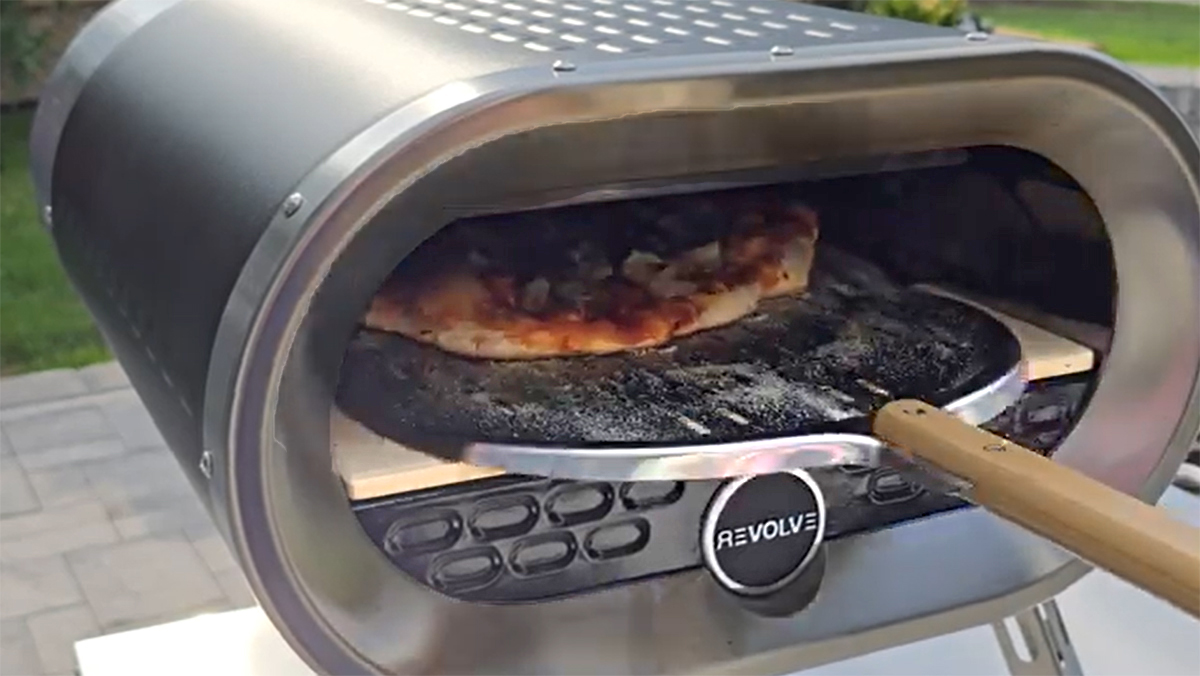
REVIEW – Mmmm….pizza. Who doesn’t love pizza? It’s hard not to given that there are so many different styles of pizza. Couple that with the fact that you can top a pizza with just about anything and you have the universal goto food for many. Pizza parlors are great, but sometimes, you want a pie without having to go out or deal with delivery. Some frozen pizzas are passable, but they sure don’t compare to pizzas cooked in those super-hot 750F+ ovens that produce that airy, chewy, and crunchy crust, melty cheese, and perfectly cooked toppings. Home ovens don’t hit that magic number and only can produce mediocre crust. What is a pizza lover to do? The folks at Revolve Pizza Oven think they have the answer. Let’s take this oven for a spin and see if it is as hot as it claims to be.
What is it?
The Revolve Pizza Oven is a propane-fired pizza oven capable of producing cooking temperatures of 850F. It has a stone cooking platform with a battery-powered rotating cooking platform that helps the oven cook evenly.
What’s included?
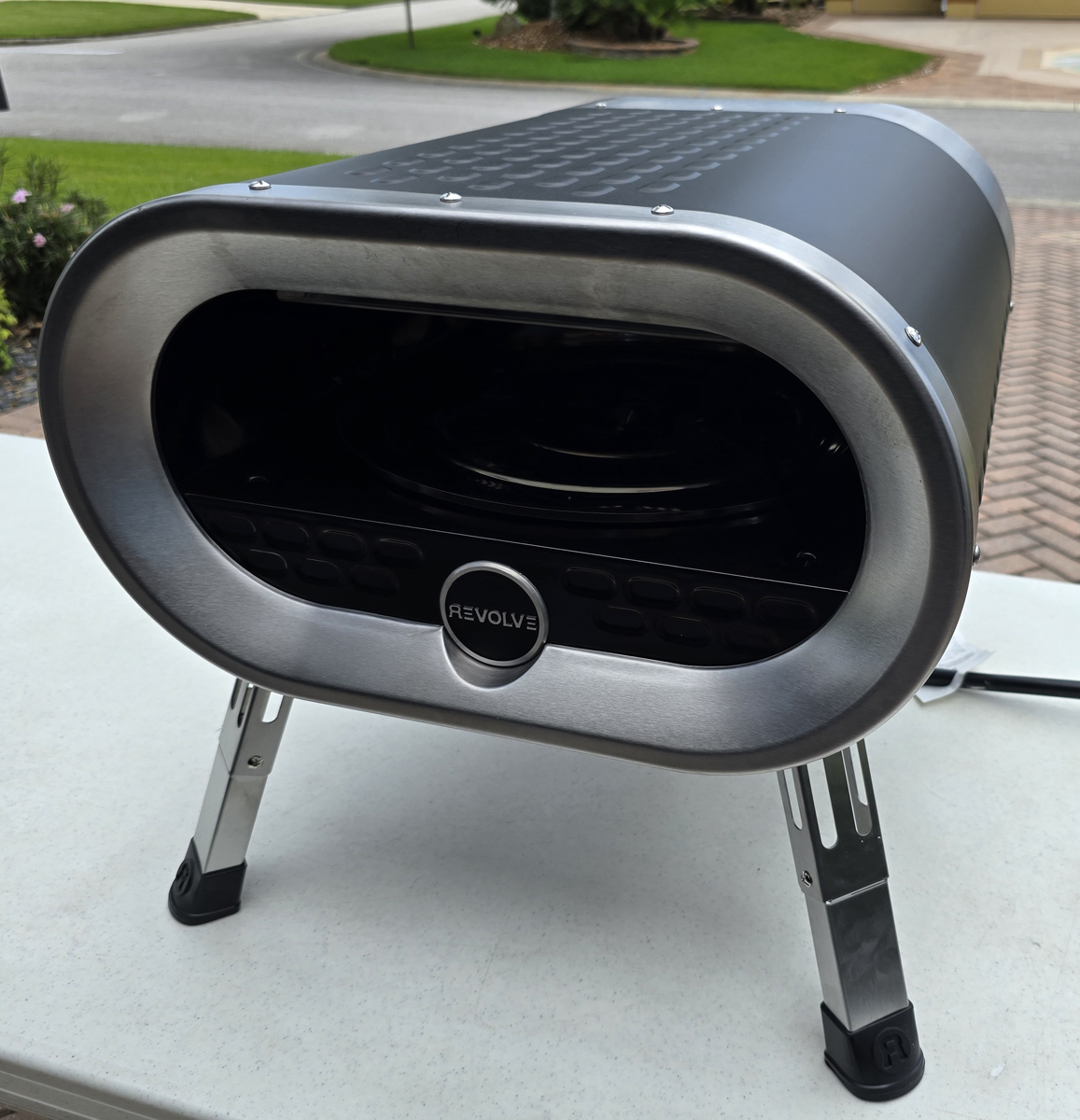
- Revolve Pizza Oven
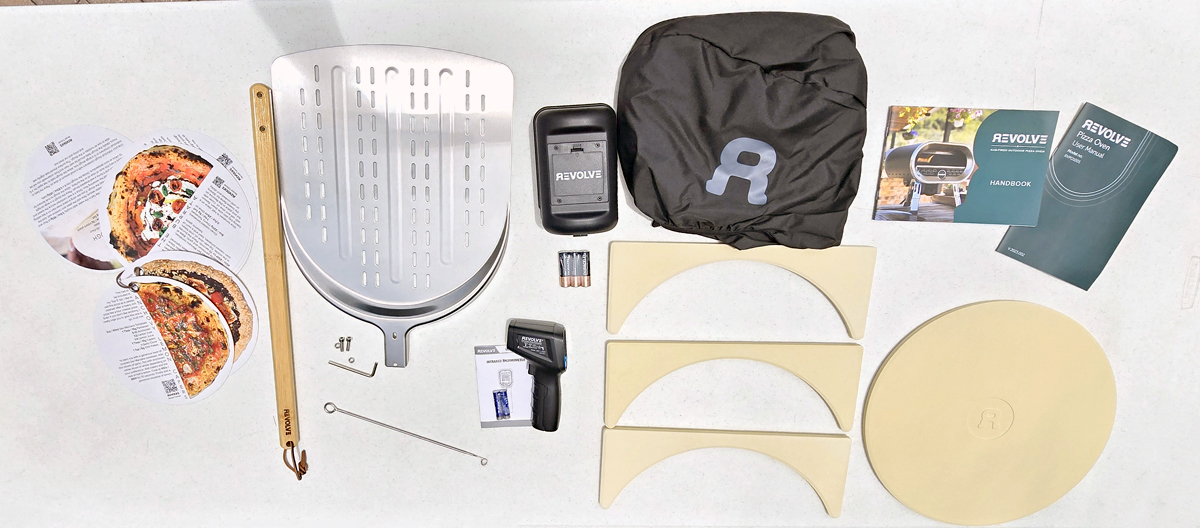
- Pizza recipe cards
- Revolve motor (battery-powered)
- Three AA batteries for the motor
- Extendable match holder for manual lighting
- 13″ Cordierite pizza stone
- Front and back stone plus a spare
- Instruction manual
- Quick start guide
- Gas regulator with piezoelectric igniter (attached to gas hose on oven)
- Bonus accessories ($165 value if purchased separately)
- Carry case / Rain cover ($50)
- Infrared thermometer (plus two AA batteries and user manual) ($50)
- Stainless steel pizza peel (handle, peel blade, two bolts and nuts, hex wrench) ($65)
Tech specs
Click to expand
Dimensions: 566 x 415 x 410mm (22.2” x 16.3” x 16.1”)
Weight: 19kg (42lbs)
Cooking Surface: 13” (33cm) Cordierite Stone (center round stone plus front and back stone)
Burner: 20,000BTU gas burner, adjustable flame
Maximum temperature: 500°C (930°F)
Fuel: Liquid Propane Gas
Ignition method: Piezoelectric igniter plus extendable match holder if needed
Rotation method: Detachable rotating motor, battery-powered (three AA batteries)
Design and features
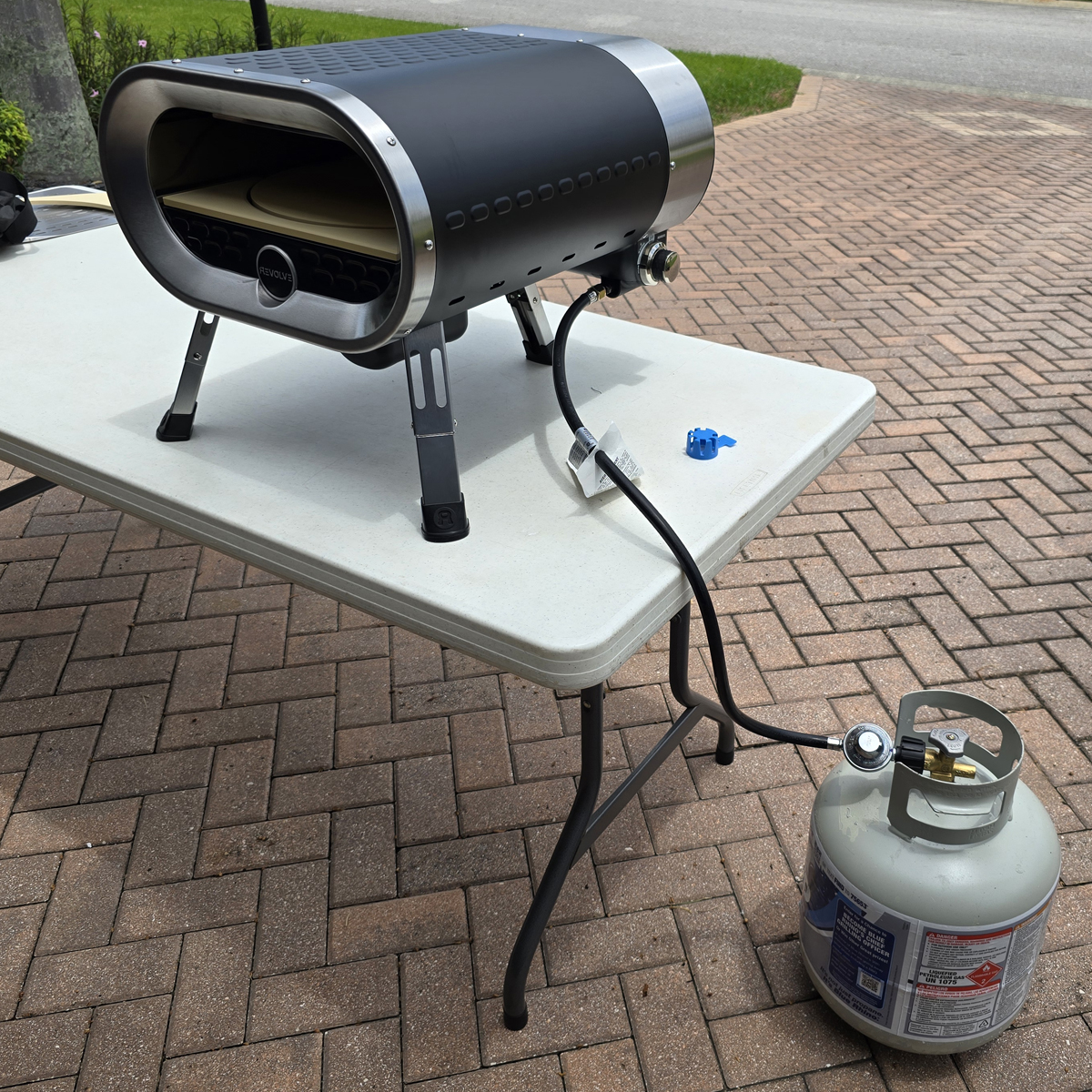
The oven is imposing and well-made. Its steel construction feels substantial and built to last. The gas line is long enough so the oven can sit on a table and the gas tank can rest on the ground.
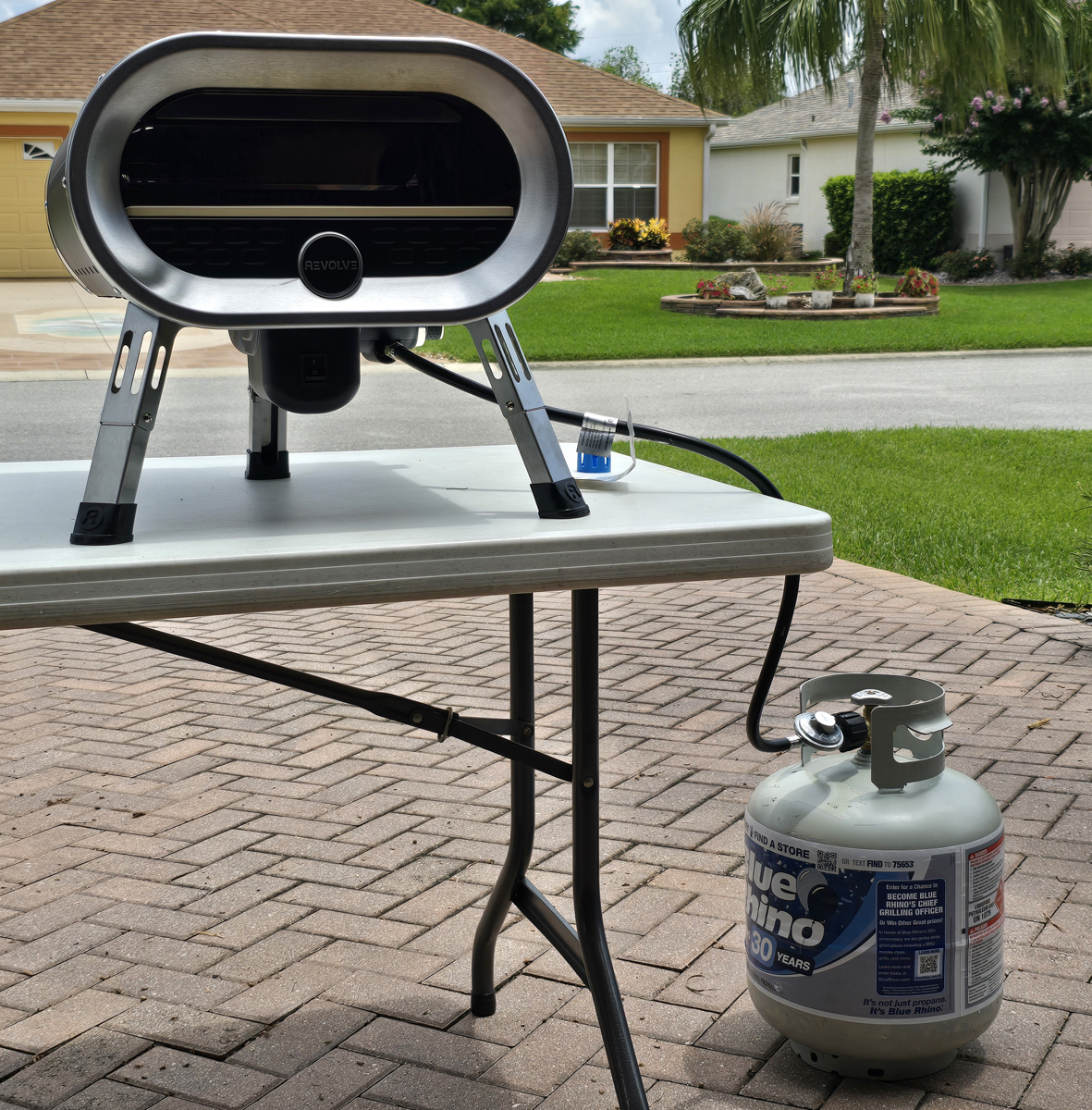
The back of the unit has multiple vents.
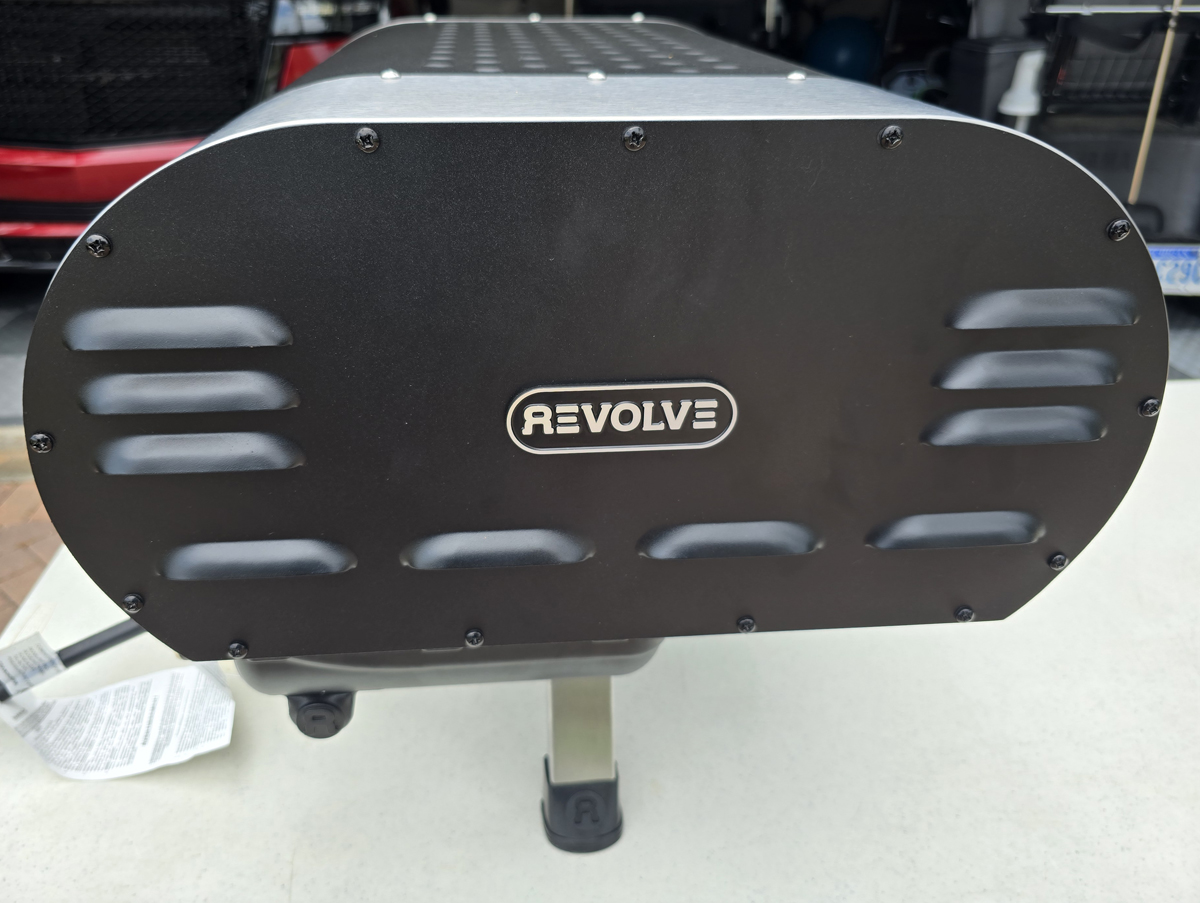
The temperature dial/igniter and gas hose are located on the back of the right side of the oven.
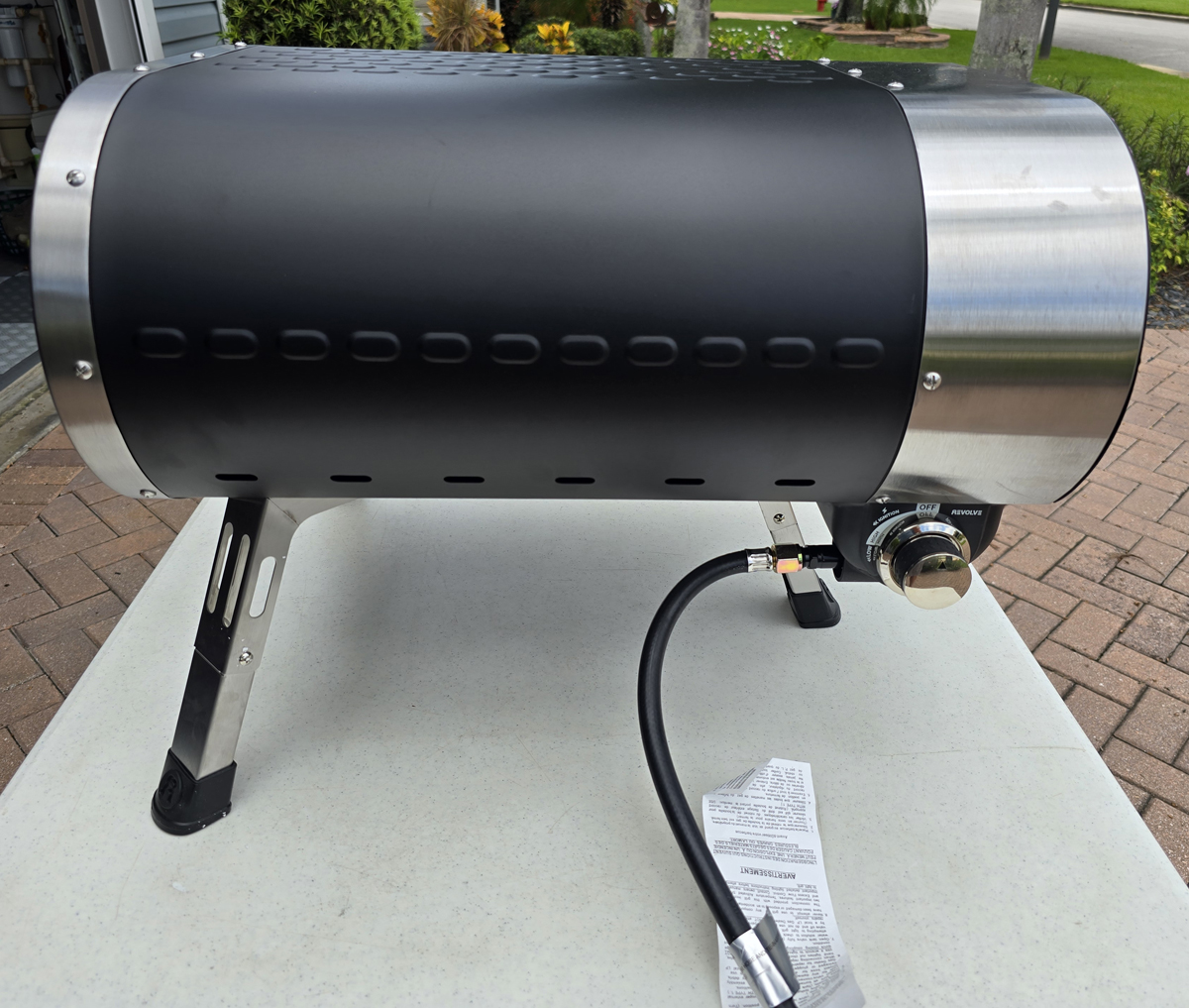
The dial rotates anticlockwise to start the gas flow and trigger the piezoelectric igniter. You push the dial in and turn it to the left. The gas starts to flow. A slight additional turn makes the piezoelectric igniter generate a spark to ignite the burner.
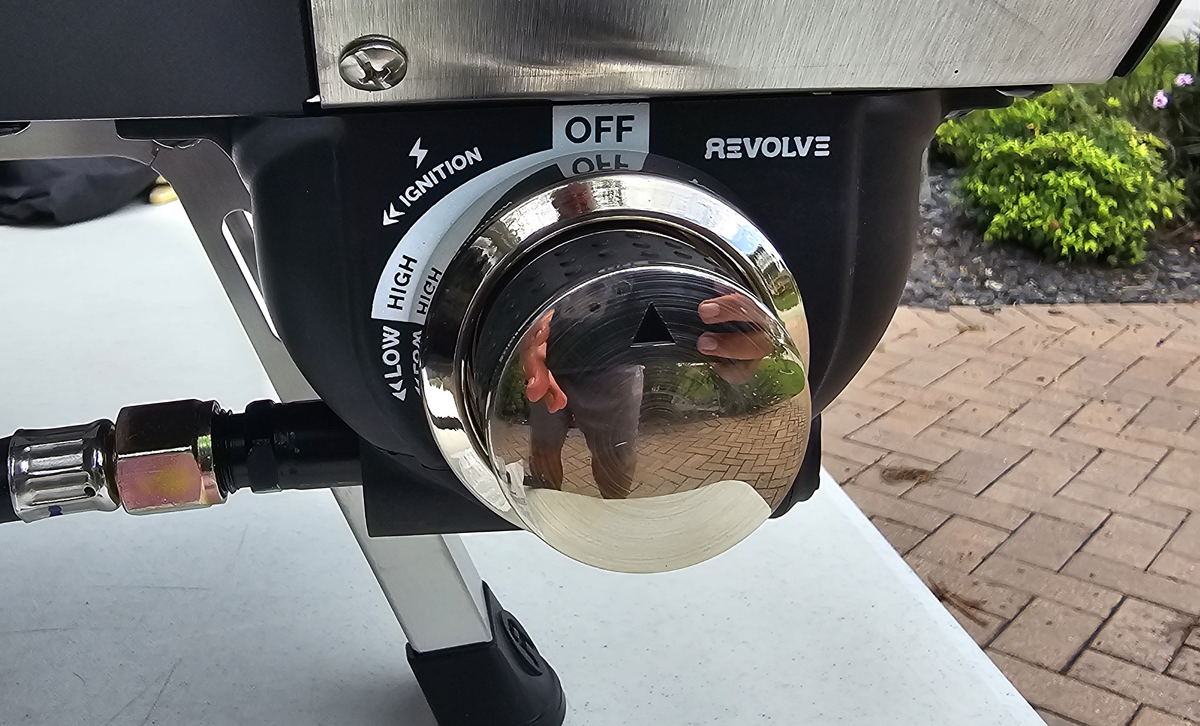
Here’s a look at the bottom of the oven. You can see the three legs and the magnetic mount for the motor.
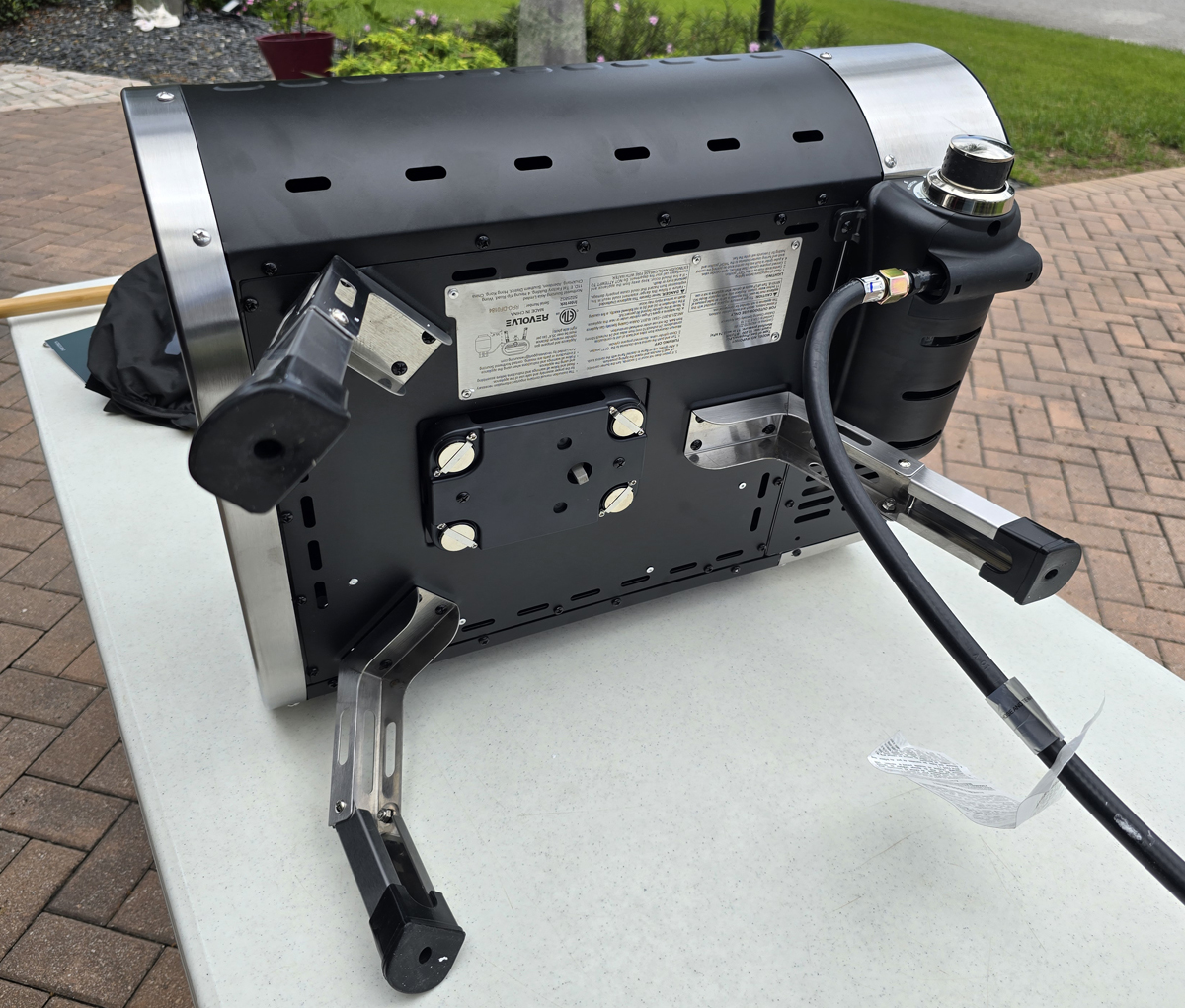
The legs can fold but I think you’ll want the legs deployed, even for storage.
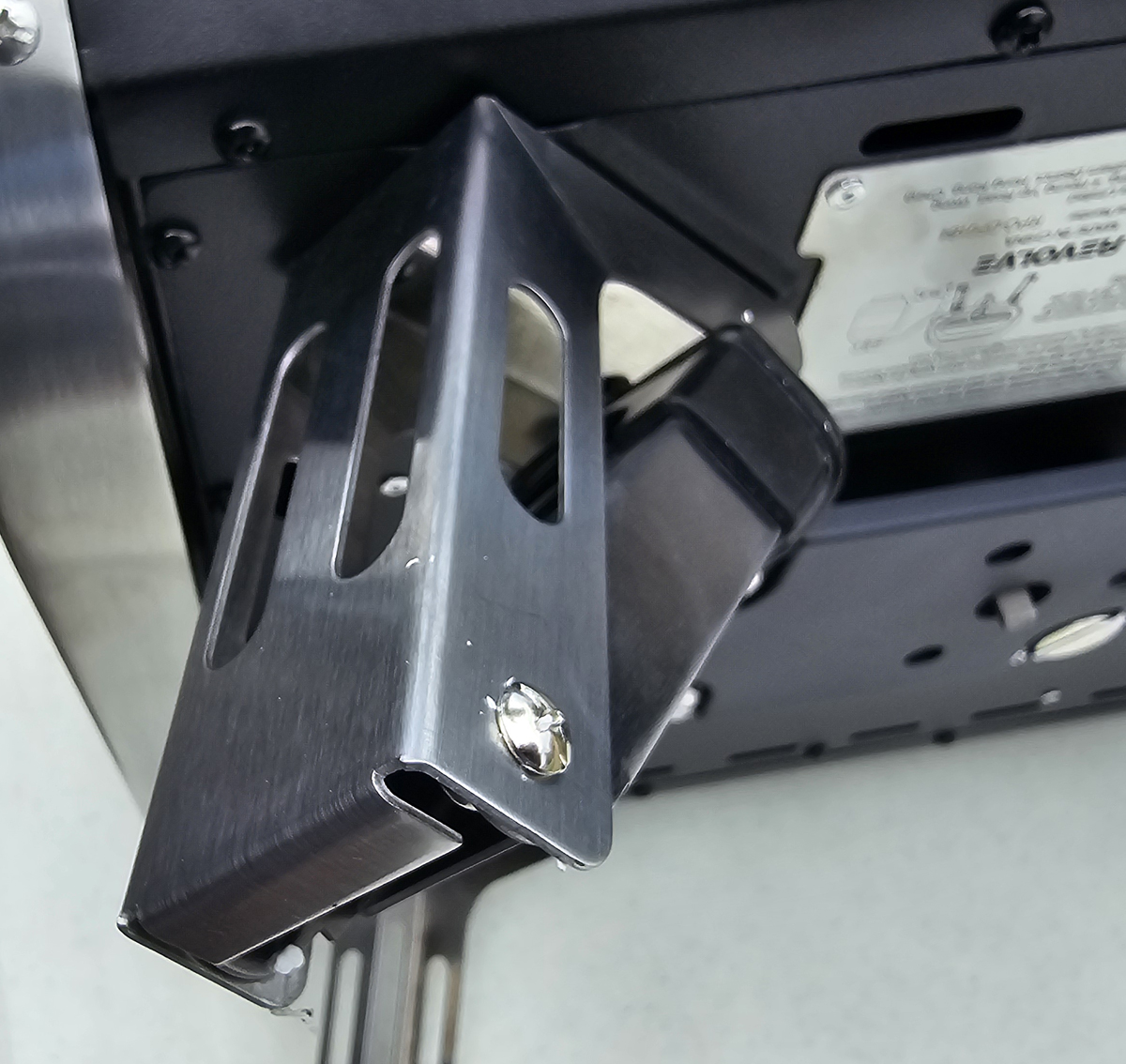
The motor mount is in the center of the bottom of the oven.
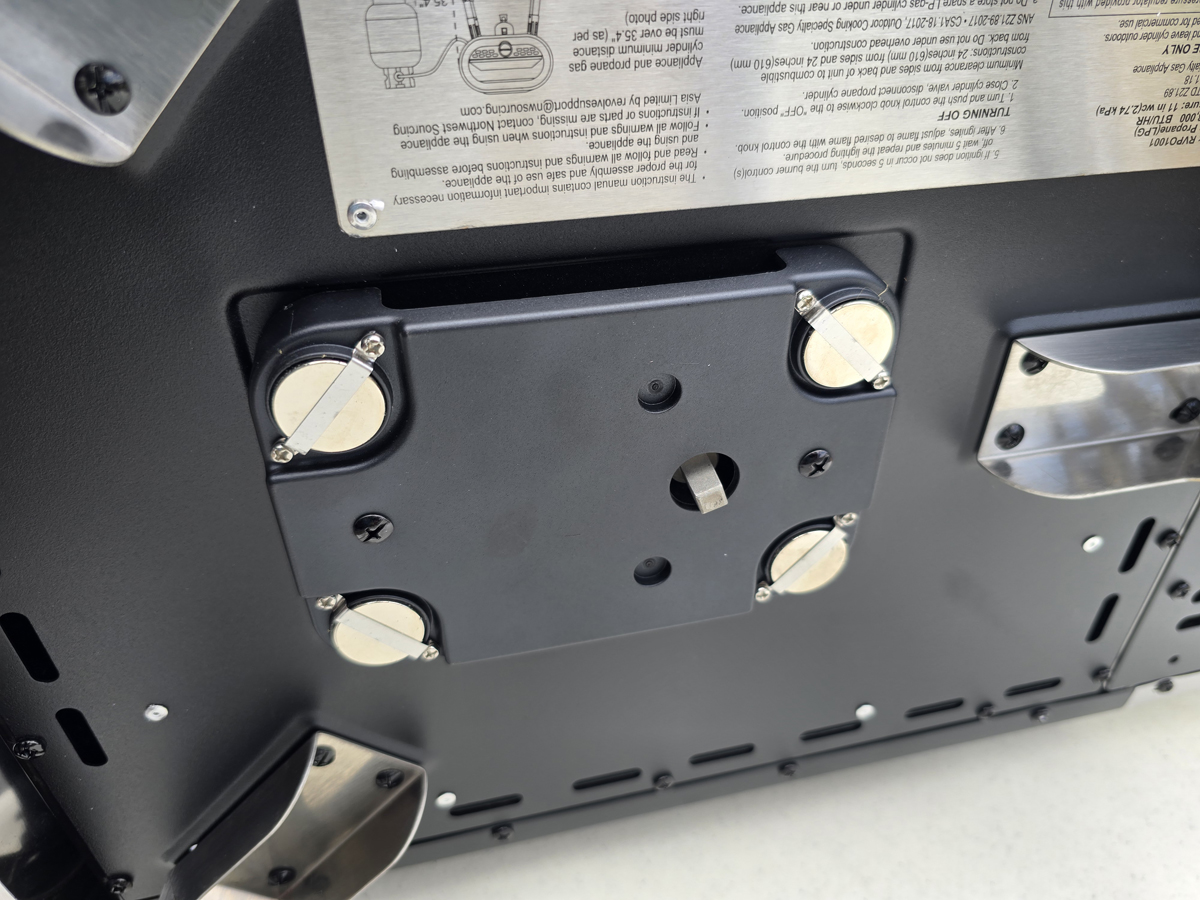
Those four silver disks are strong magnets that cause the motor to snap into place.

You have to line up the axel extending from the bottom of the oven with the socket on the motor. It can be a little fiddley, but it attaches fairly easily. In the photo below, you can see the battery door covering the three AA batteries that run the motor.
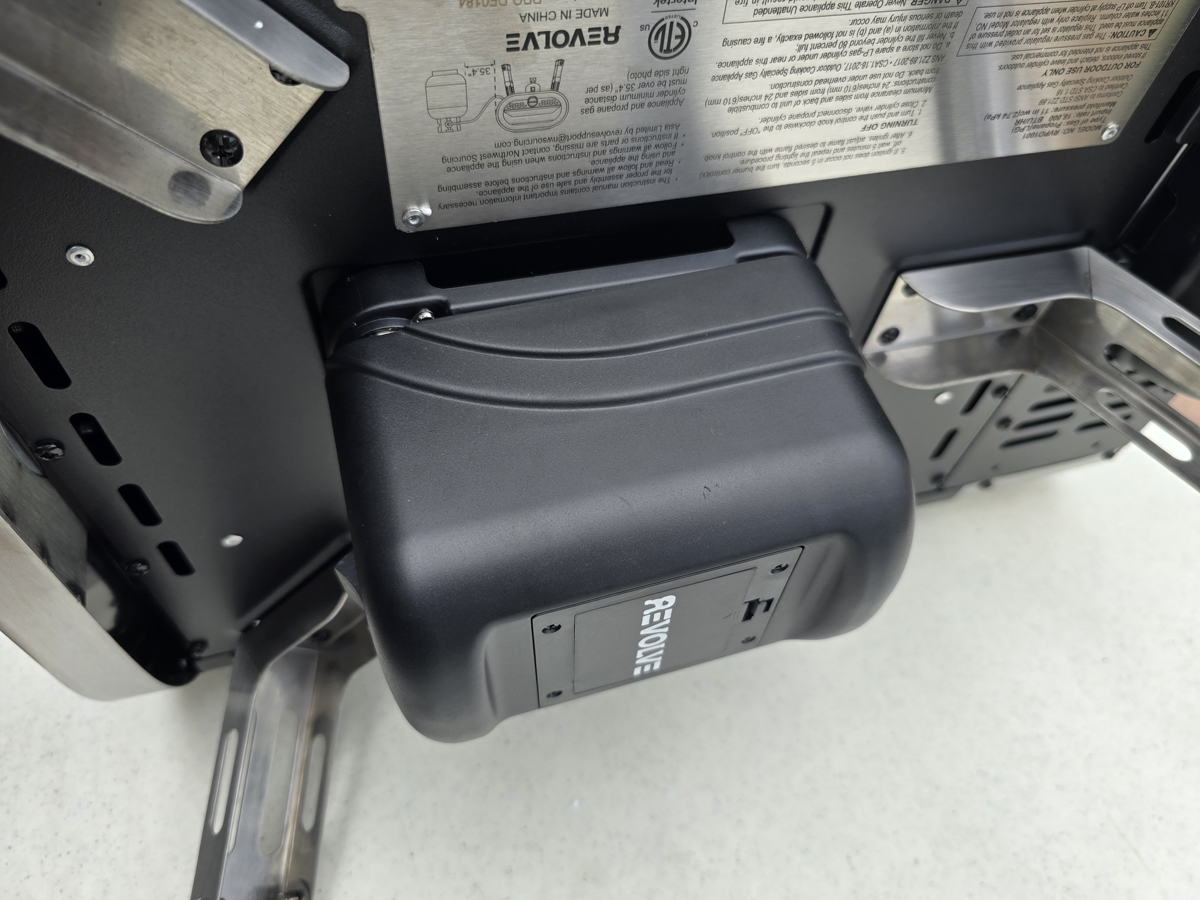
The cover is fitted and quite tight. It stretches over the oven and is secured with clips under the oven.
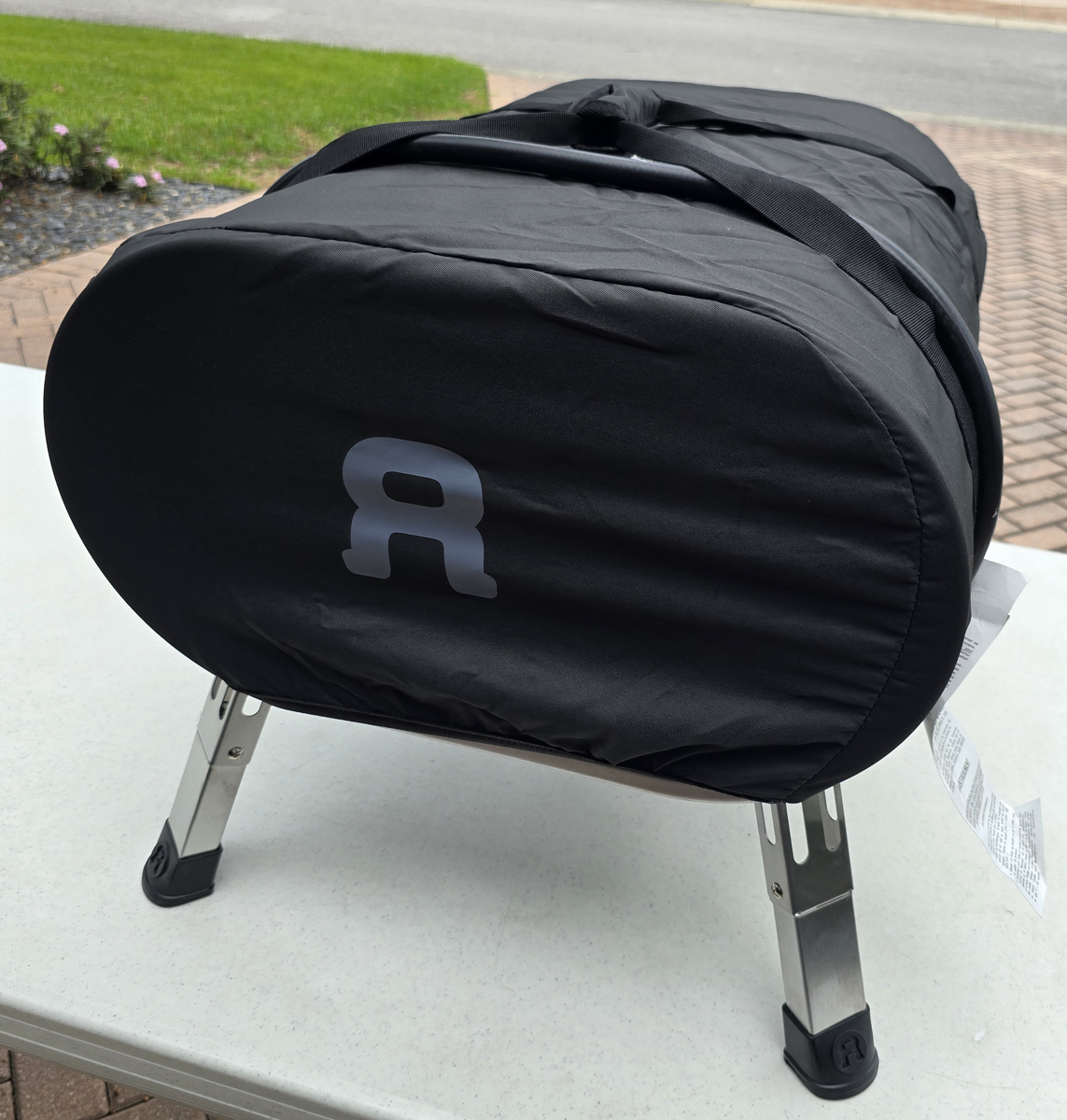
The carry handle on the top makes it easier to lift the oven, especially given its 40+ pound weight.
Assembly, Installation, Setup
The only setup required is to install the three stones, install the motor batteries, snap the motor in place, and connect the gas line. Here, you can see the rear stone installed.
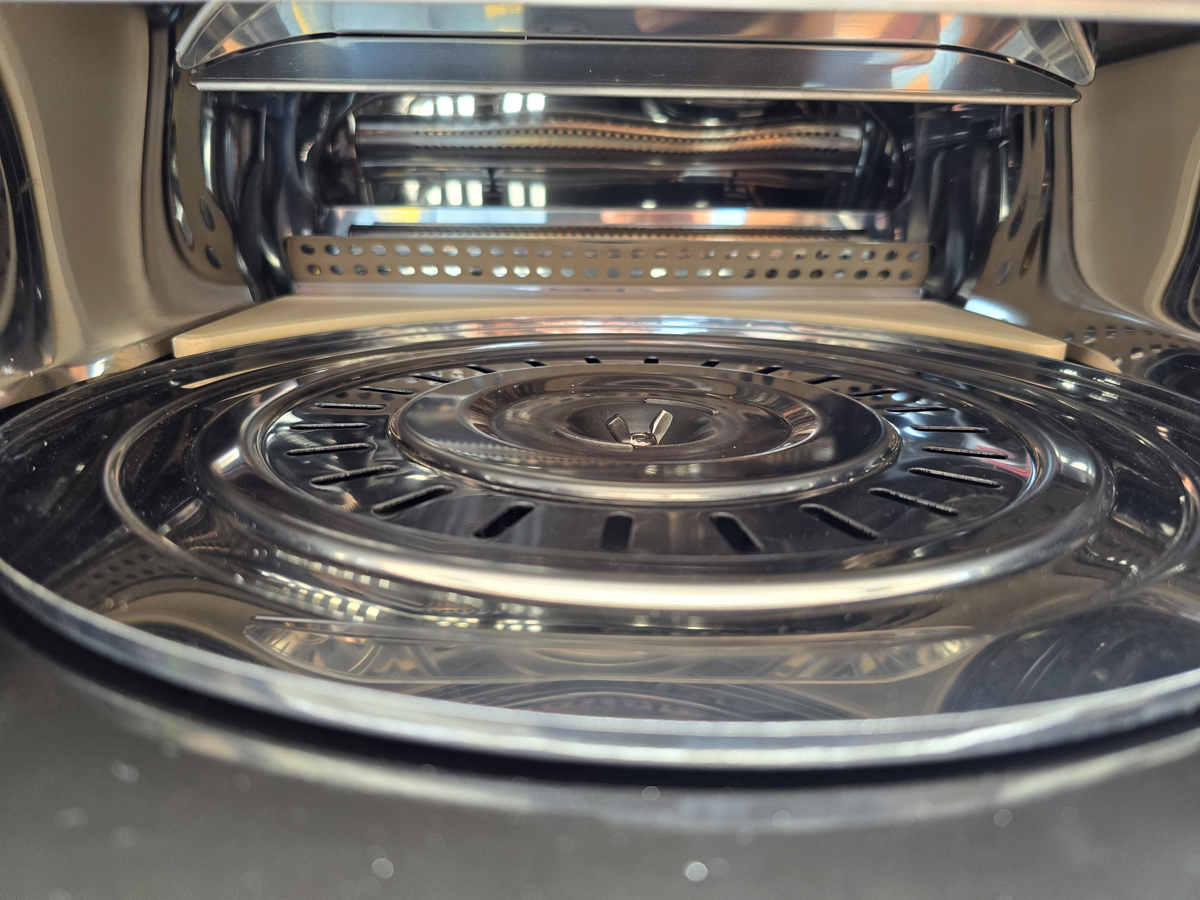
And here you can see all three stones in place.
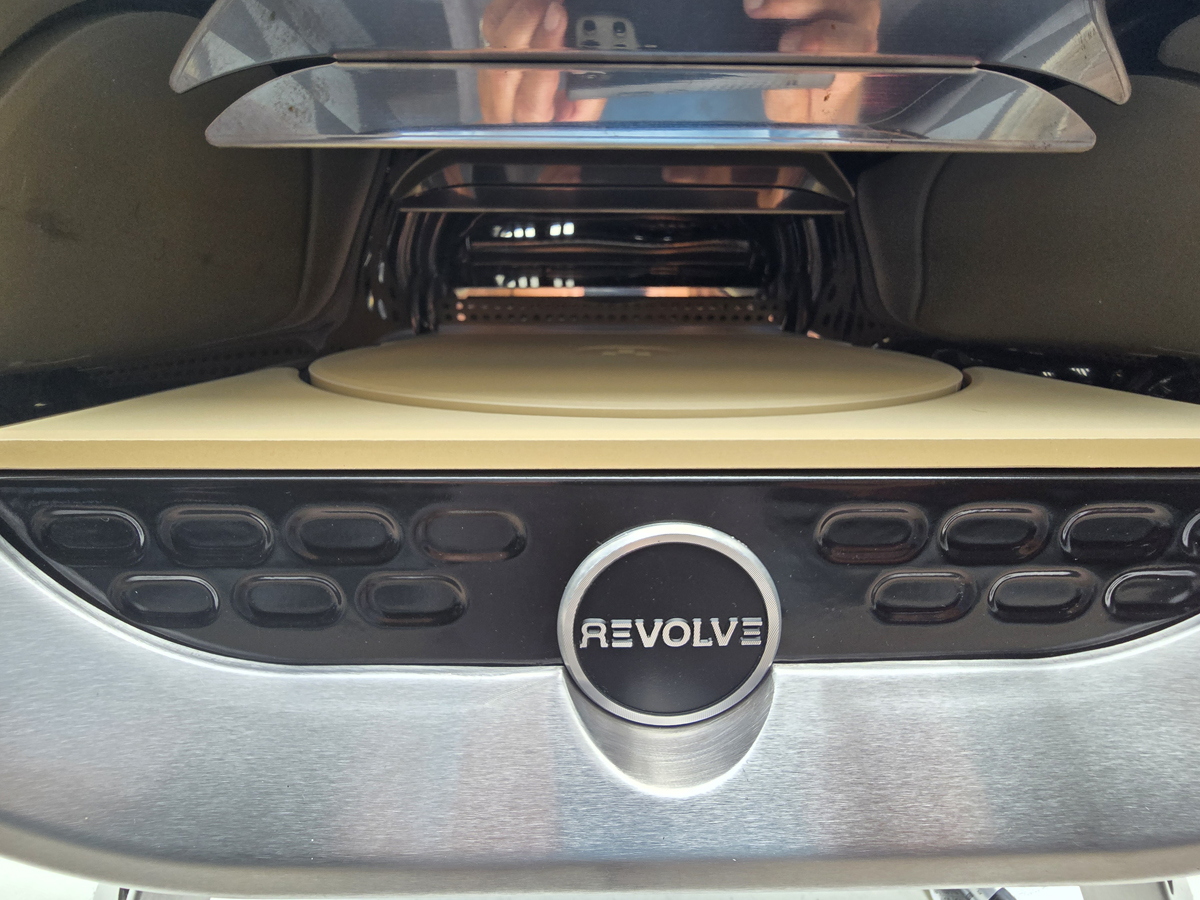
Here is the oven, stones installed, motor installed, and ready to hook up to the propane tank.
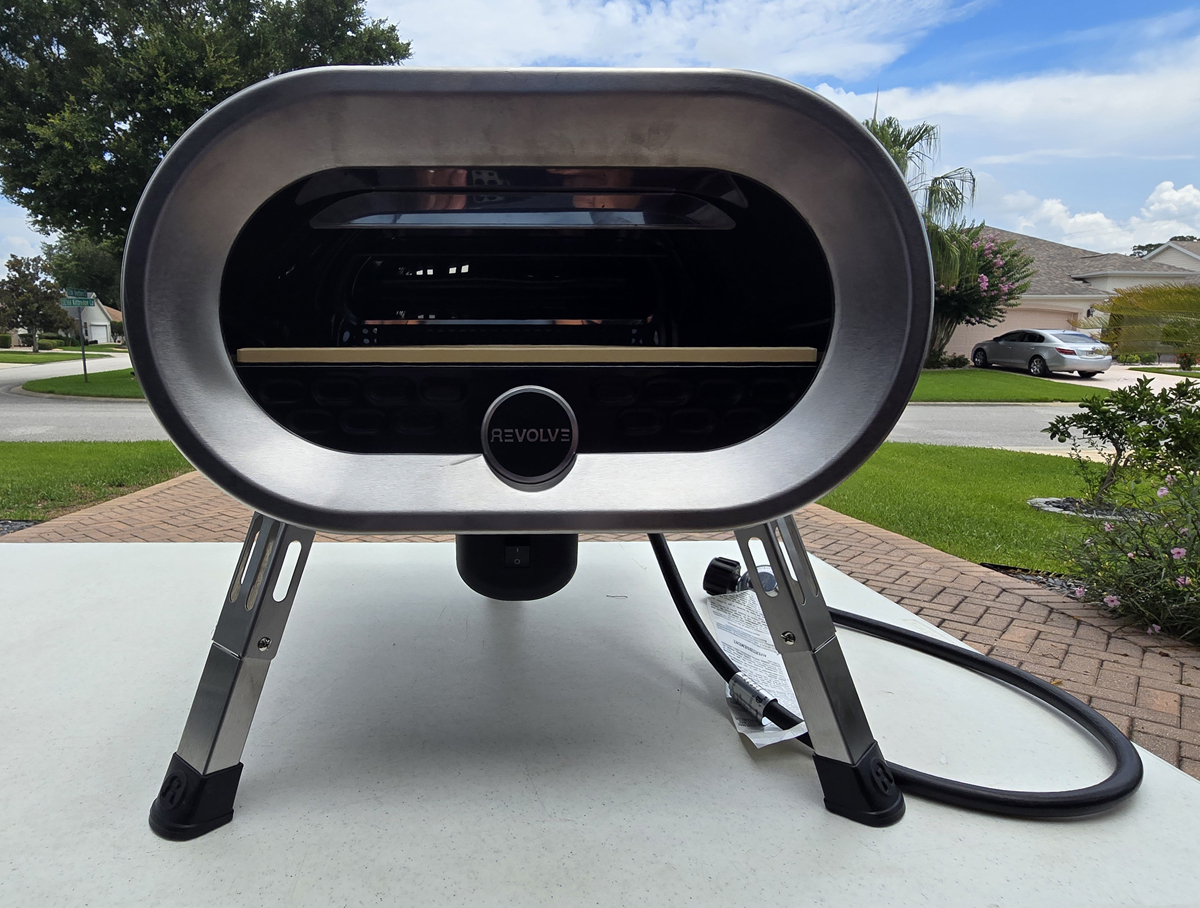
The other thing to assemble was the peel. Two bolts, two nuts, and a hex wrench take care of that.
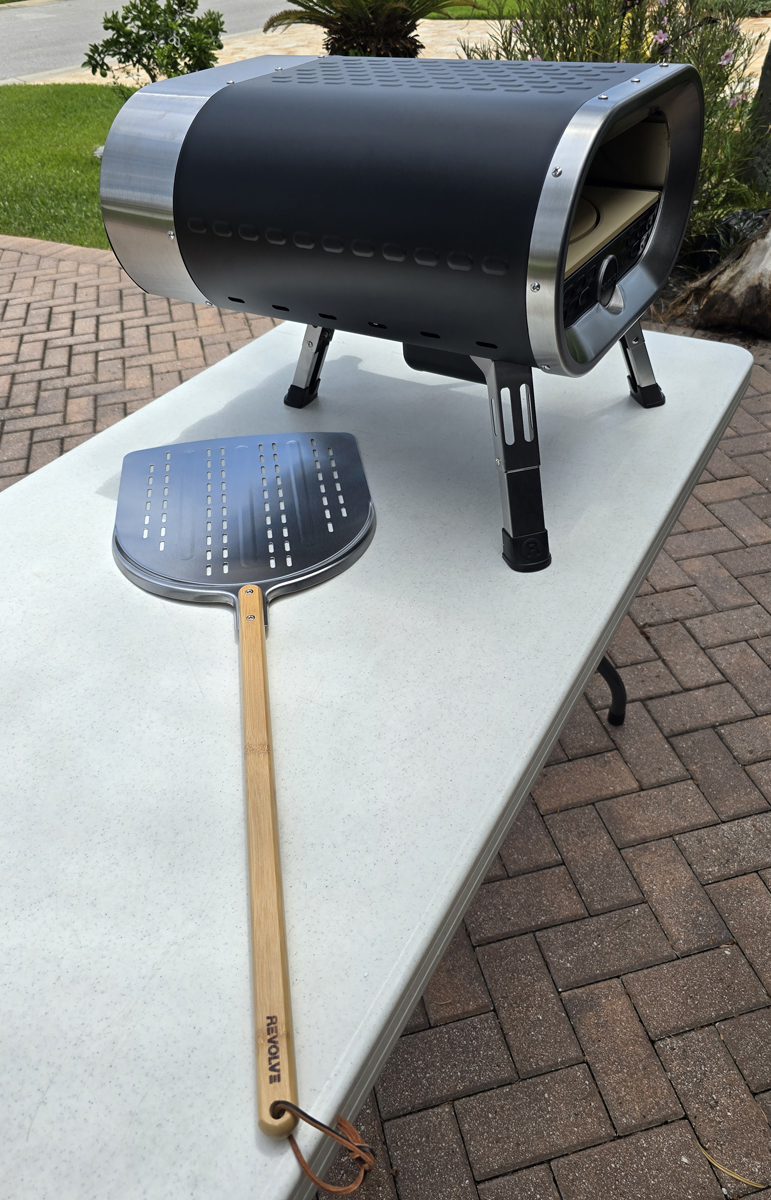
Performance
I hooked up the propane tank, turned the dial, and the oven sprang to life. You push the dial in and slowly turn it counterclockwise until the igniter clicks. If I let the dial pop back out immediately, the flame would go out and I had to start the process again. Once the igniter clicks, keep the dial depressed for several seconds and then let it out and the oven will stay lit. This is a typical lighting method for these types of burners. Once lit, you can make out the blue flames in the back and the flame sheet curling up along the top of the oven.
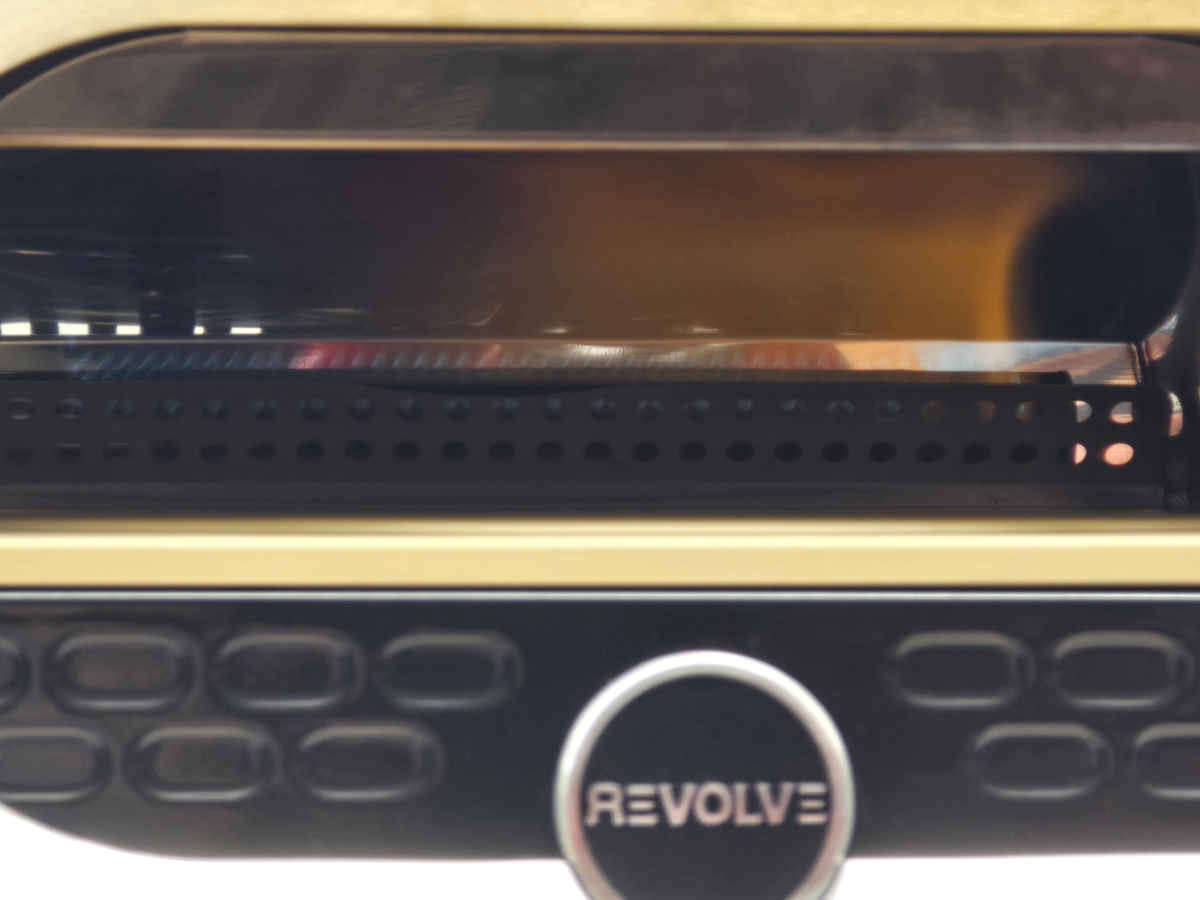
In roughly 20 minutes, the included laser temperature sensor recorded nearly 600F at the center of the oven.
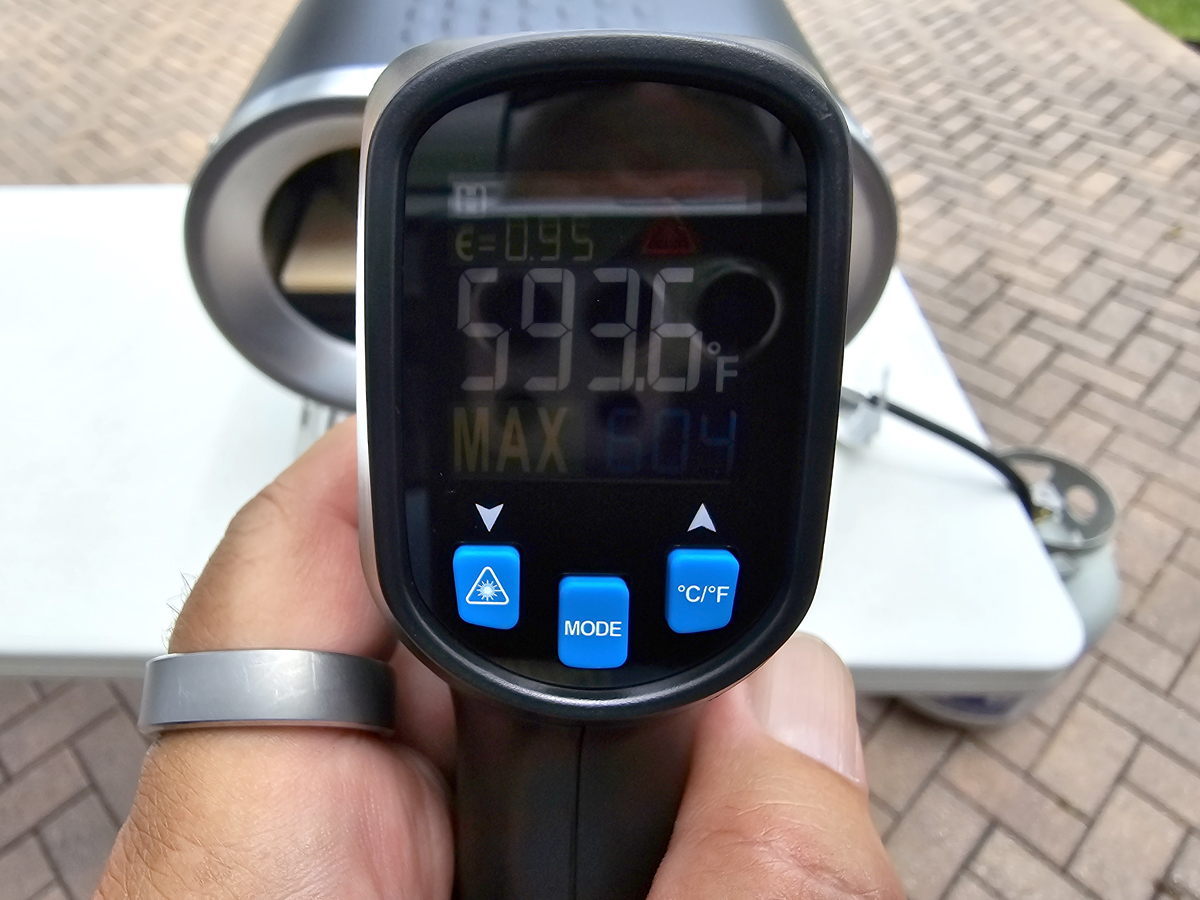
At around a half hour, we were topping 800F!
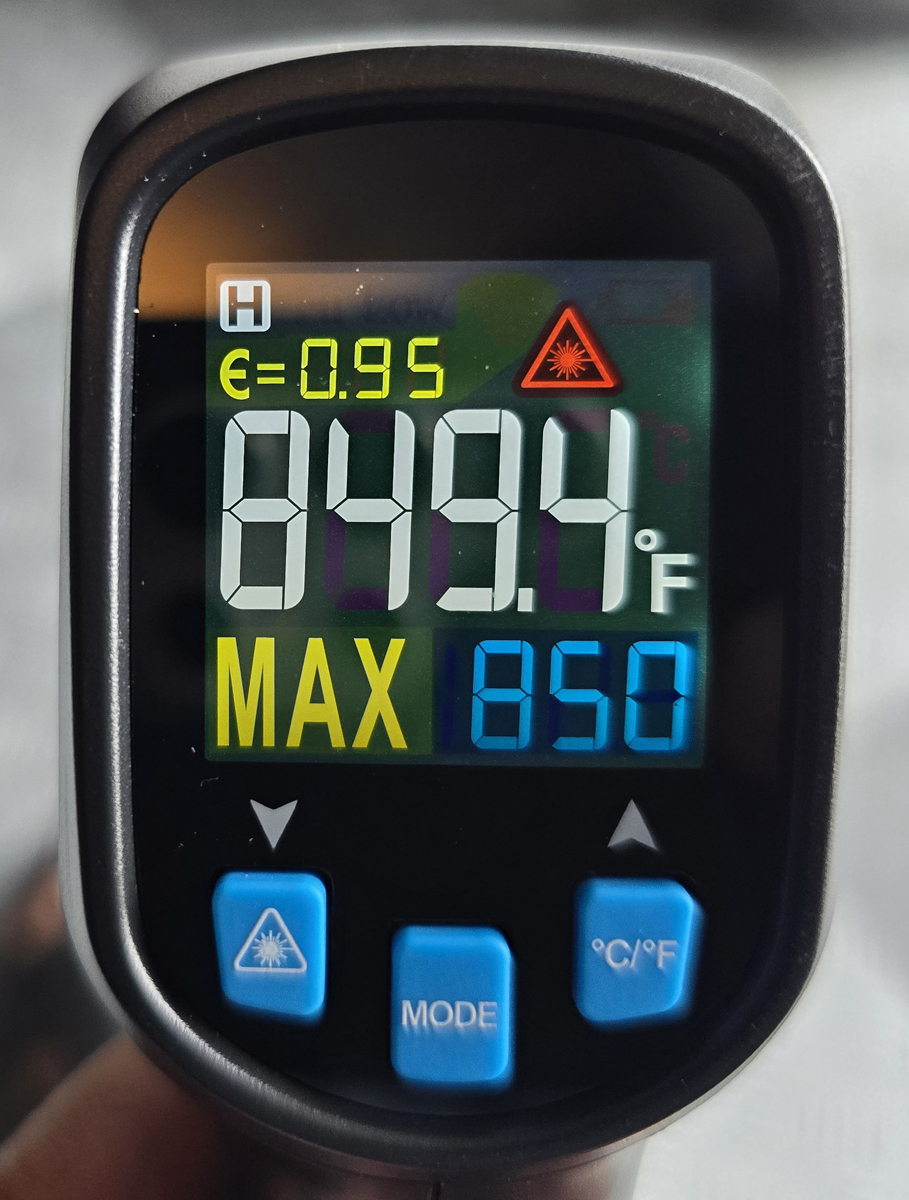
I was a little concerned, given that I had the oven sitting on a plastic table. Doing a quick temperature check, I saw that the table’s temperature was only 106.5F, or roughly 10F above the ambient temperature of 95F. Nice!
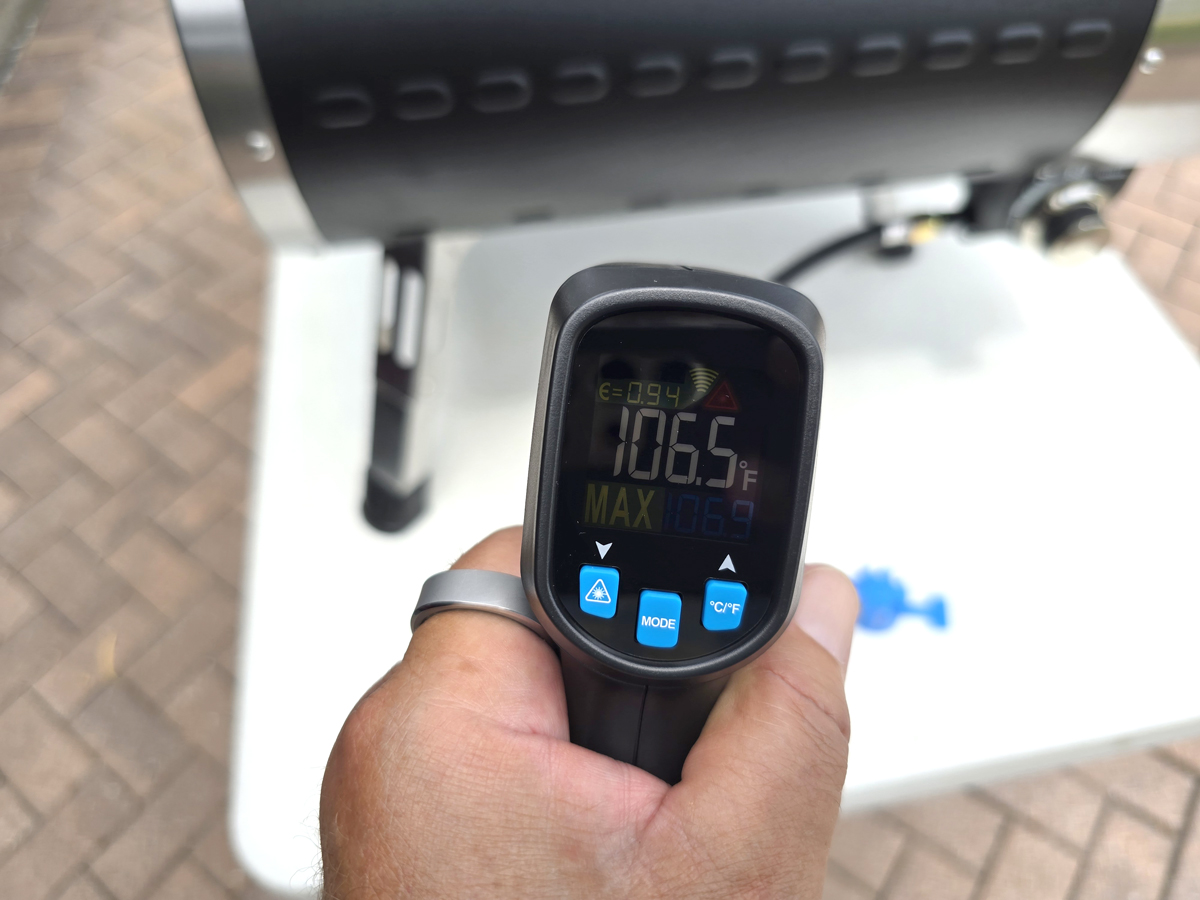
For this first test, I was just going to fire up the oven and check the temperature. My wife suggested that as long as the oven was hot, she would run to Publix and pick up their ready-made pizza dough and we could try cooking a pie. Alrighty, then…we’re doing a full test!
We had to let the dough warm up to room temperature so I wouldn’t crack the stone. She let it warm and then started stretching it. Because it was still a little cool, she could only stretch it so much. She got it stretched to a 13″ circle. It was a touch thick. To further complicate things, we dressed it up with sausage, bacon (slightly overcooked already), pepperoni, and a whole bunch of cheese. To be clear, this isn’t the type of pizza that cooks fast. No matter, I slid it on the peel and into the oven. I also turned the temperature dial down, as the instructions suggested so that the top of the pie didn’t burn.
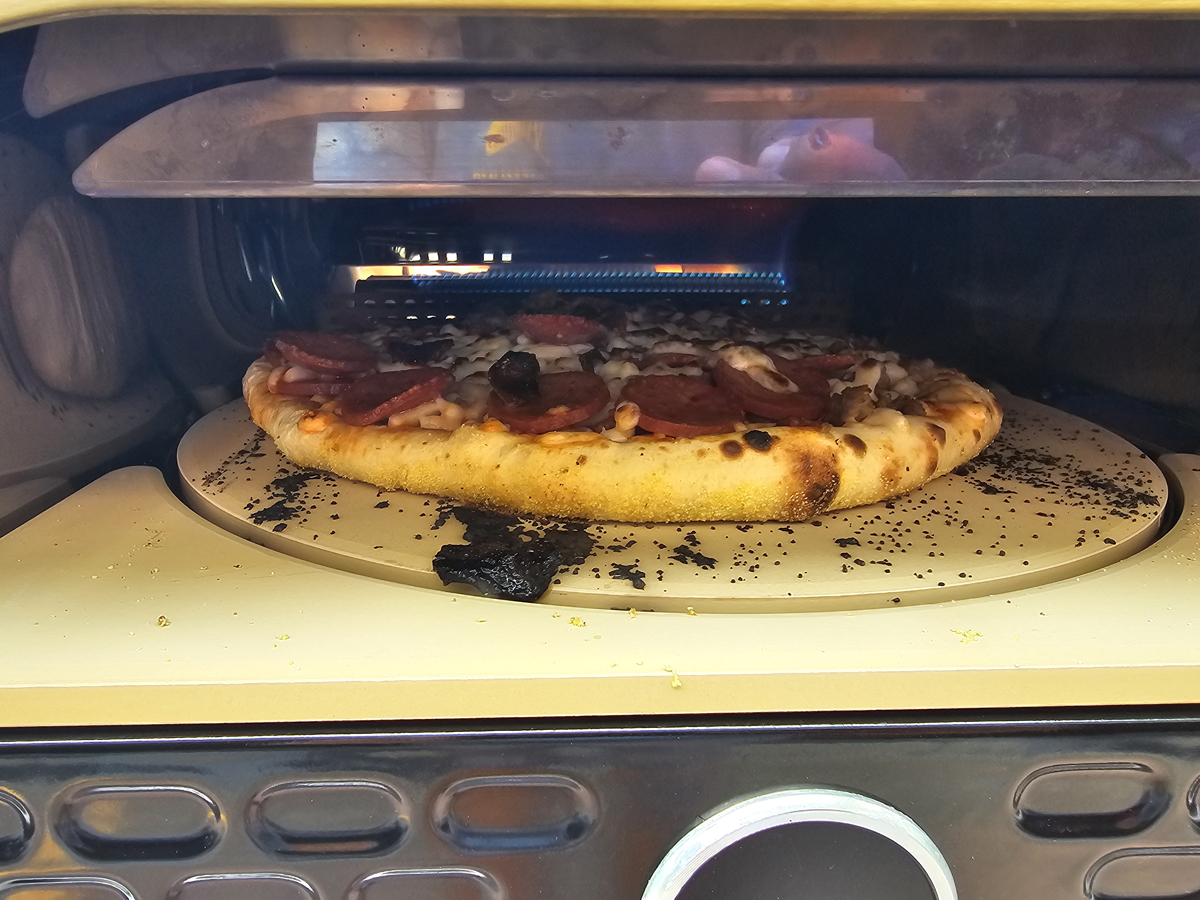
In roughly 90 seconds, it looked terrific, so I slid the peel under it and brought it out. It looked delicious. Again, for the record, the bacon was already overcooked by accident – the Revolve oven didn’t destroy the bacon.
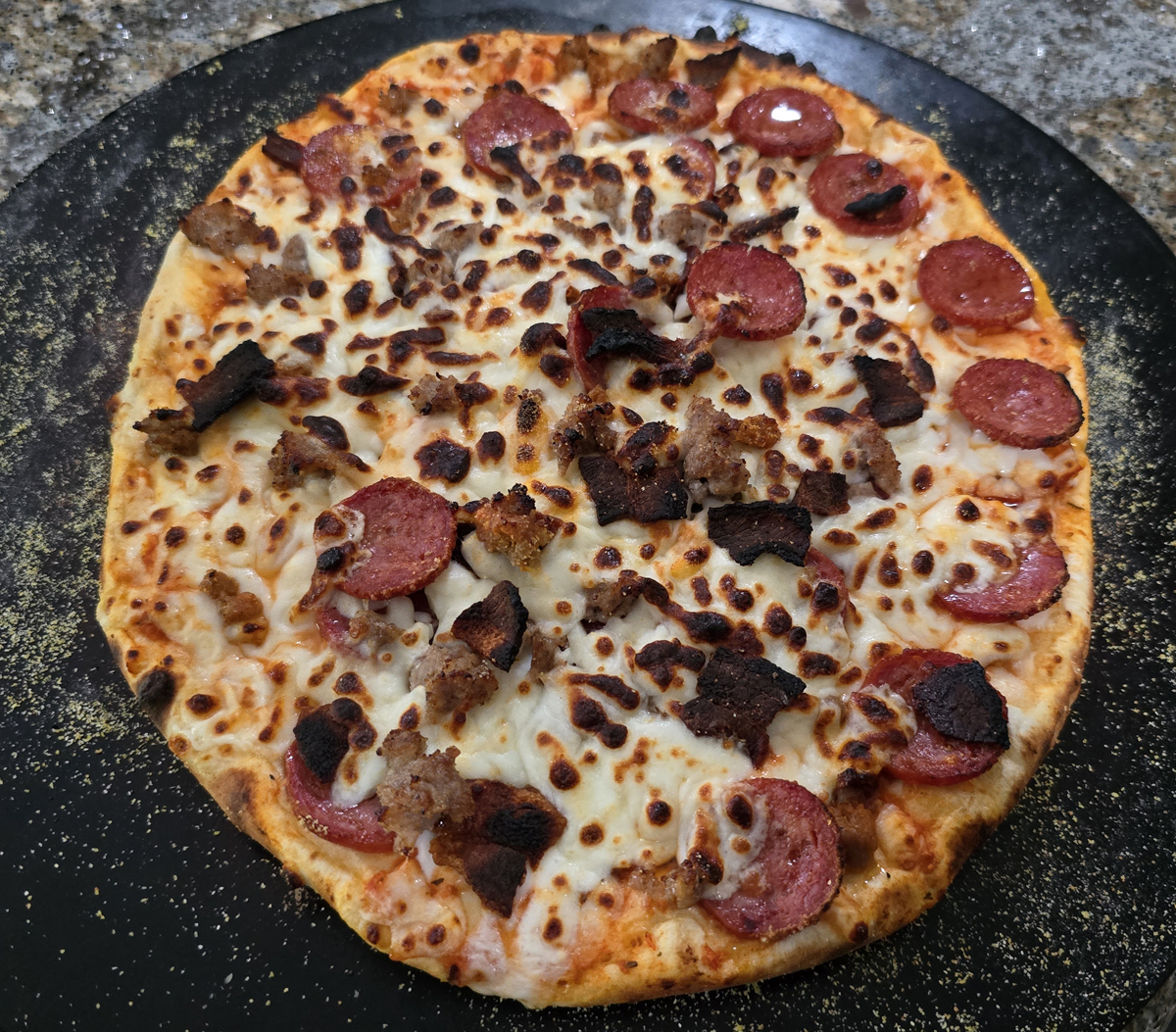
At first slice, it looked pretty darn good.

Trying it, however, gave different results. The thicker parts of the crust simply weren’t cooked. It was doughy and almost raw. This is not the fault of the oven at all. We made a much different style of pizza than this oven is designed to cook. I slid it back in the oven for another 90 seconds. That helped, but it still needed more internal cooking time. For this type of pizza, I think the answer is to bake the crust for 60-90 seconds first, then top it, and cook it again for perhaps two minutes. We will experiment with that. To be very clear, we did not follow the included dough recipes and used pre-made general-use pizza dough. Revolve provides a couple of recipes for dough specifically for this type of cooking. We tried that as well a few days later. The issue is that dough recipes take a day or two to prepare and honestly, we don’t plan to make pizza that far in advance!
Because the pizza was loaded with toppings, and I removed it and then put it back in again after slicing it, I made a bit of a mess of the stones. The instructions say to keep the oven running at full temperature for about 30 minutes to clean the stones. I did and this was the result. Almost everything was incinerated and turned to ash. It did discolor the stones but that is to be expected. I rinsed them off and put them back in the oven for the next bake.
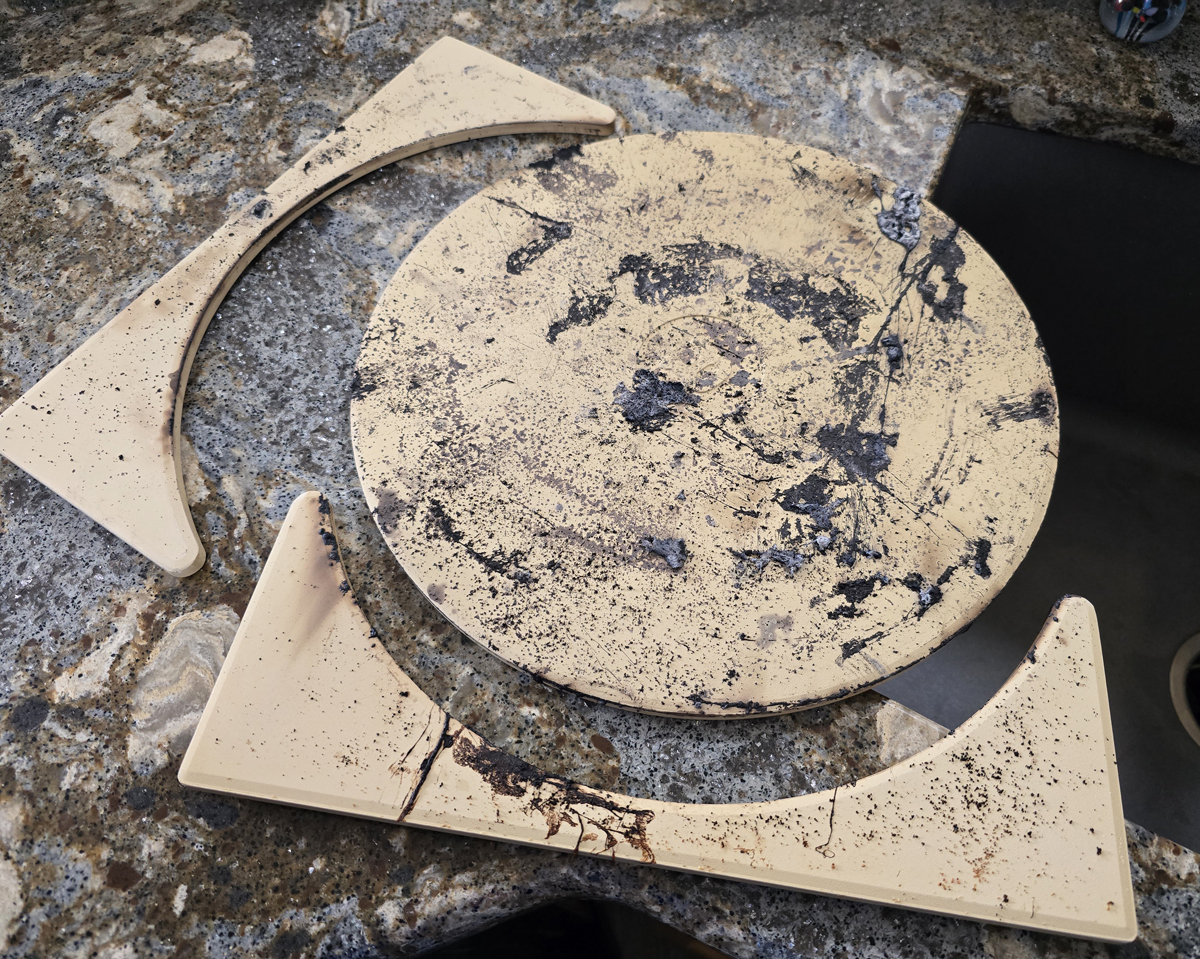
A few days later, we gave it another go. This time, my lovely wife bought some of the recommended “00” flour rather than using pre-made pizza dough from the store. That is milled extremely fine and is used in traditional pasta and pizza dough. It only takes four ingredients – flour, water, yeast, and salt, but it does take at least 18 hours to fully prep the dough. This time, she was able to get a thinner crust rolled out. We had some friends over as guinea pigs for dinner. My wife rolled out the dough and we let it sit for a bit before dressing it. I think this was a mistake as it let all the moisture in the dough seep to the bottom, turning the dough into rubber cement, adhering to the pizza stone we were using to prep the pies. That made it all but impossible to slide the peel under the dough. We slowly pulled it up and sprinkled some semolina flour under the crust. That worked and I was able to slide the peel under the crust but it was rough going. I think we need to roll out the dough with some semolina flour under it, prep the pie, and cook immediately. These issues have absolutely nothing to do with the Revolve Pizza Oven, but I want you to understand the entire process, so I’m including these pain points. On to the cooking!
With the grill fired up to full temperature, I turned the burner down and slid the first pie in. I closely watched it. Right when I saw little areas look like they were just about to burn, I slid the peel under the pizza and removed it. That took less than two minutes. I cranked the oven back up and let it warm back up as it cooled to a little under 700F during the cooking process. A couple of minutes later, it was back up to temp and the second pie went in. Here is a look at the entire process and results.
As you can see, the pizzas came out looking terrific. I can confirm that they tasted equally good. Our guests agreed and were quite impressed with the speed of cooking. The revolving stone does an outstanding job of evenly cooking the pizzas. There were no overdone or underdone areas. Everything was cooked well.
A couple of days later, we had more friends come over as test subjects for pizza and we tried the more immediate cooking method. Putting semolina flour down under the crust, and dressing it quickly for cooking helped a lot. With our second group of friends, we cooked up four pizzas. I started each pie cooking when the stone was at 750F or higher. I turned down the burner so the toppings didn’t scorch and let the Revolve Oven do its thing. After roughly 90 seconds in the oven, I pulled the perfectly cooked pizza out and turned the burner back to high. The stone had cooled to around 650F while the pizza was cooking. It took a few minutes to get back above 750F. I wish the oven didn’t need that much warm-up time between pizzas, but that is what it is. I repeated the process for the other three pies. In short order, we had four perfect pizzas and chowed down. Rave reviews were given all around. Comments included compliments on the crispy yet chewy nature of the crust, the melted and crusty cheese, and the seared toppings. All four pizzas were perfect. We don’t get pizza like this out of our kitchen oven.
The Revolve Pizza Oven can do more than cook pizza. Revolve sells a cast iron pan accessory that you can use to cook steak or grill veggies. Unfortunately, as of this writing, none of the accessories from Revolve were in stock. I checked with Revolve and they have no date for when accessories will be available for purchase. Other competitors make them as well and I’m going to pick one up and try some high-temp steak cooking soon. For the moment, I’ll just be baking pizza.
The specs claim that the oven can reach 930F. I couldn’t get it above 865F in the center of the stone no matter how long I let it heat. It was just over 900F near the back of the oven, closer to the flame. Since the stone rotates, the edges do get that super-high temperature blast as it rotates past.
One thing I think could be better is the cover. While it is nice and attaches securely, it is tight – extremely tight. I struggle to get the elastic ends over the oven. I’m concerned that it won’t last very long and I will tear it as I try to stretch the cover over the oven. Time will tell.
What I like about the Revolve Pizza Oven
- Well-made
- Heats reasonably quickly and gets hot hot hot
- The revolving stone ensures even cooking
- The oven produces perfectly cooked pizza in around 90 seconds
- The included thermometer, peel, and cover are nice additions
What needs to be improved?
- The cover could be a little larger
- It takes longer for the oven to warm back up between pizzas than it takes to cook the pizza – that slows the process but I don’t know how you could fix it
Final thoughts
I didn’t know what to expect with the Revolve Pizza Oven. I have to say that I am very happy with it. It heats well, does a terrific job cooking the pizzas, and mostly cleans itself by incinerating any spills. We plan to continue experimenting with dough and technique so we can perfect the process. This is a terrific oven if you’re a pizza aficionado and like to entertain. Our lab rats guests enjoyed creating their pizzas and watching them as they transformed from raw dough pies to perfect pizzas in just 90 seconds. We got lots of “Wow, that’s amazing”, and “This is delicious”, comments.
I’m excited about the possibility of steakhouse results by cooking some steaks at high temps just like the expensive places. Once I procure a cast iron tray for the oven, I’ll give that a go. I’ll also be trying some grilled veggies as those are supposed to be amazing as well. Is this an everyday oven? No. Will it get used frequently? Also, a likely no. But, as a specialty cooking tool, it produces excellent results with a minimum effort. And who knows? As I experiment with other cooking tools, I might find that the Revolve Pizza Oven will become a regular weapon in our cooking arsenal.
Price: $599
Where to buy: Revolve Pizza Oven
Source: The sample of this product was provided for free by Revolve Pizza Oven. Revolve Pizza Oven did not have a final say on the review and did not preview the review before it was published.


